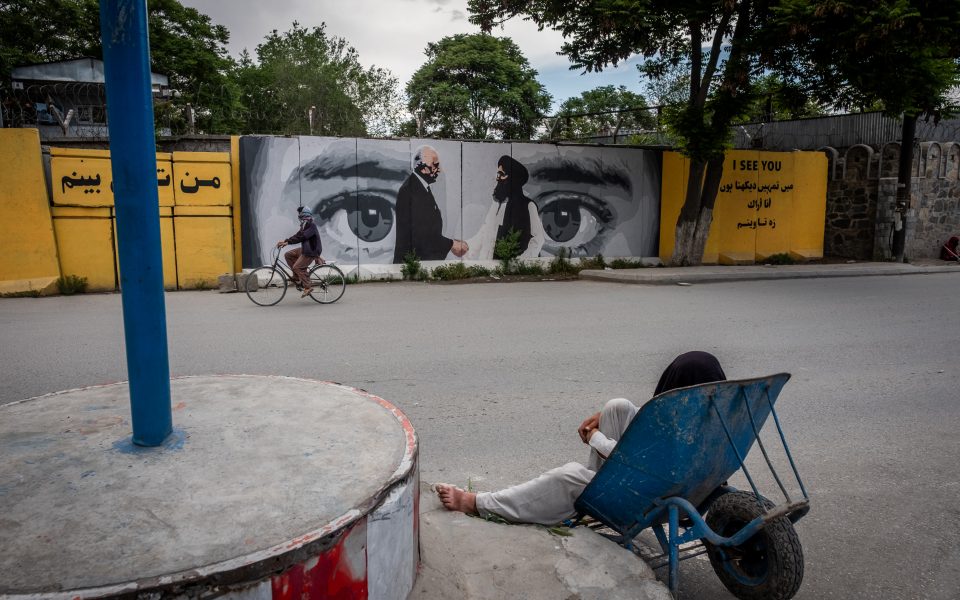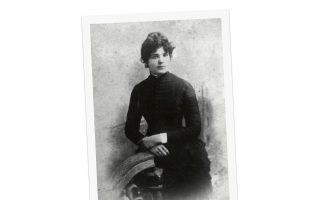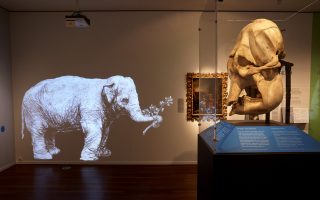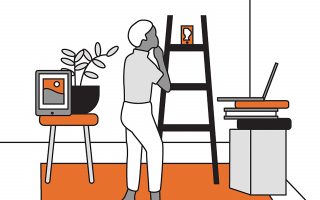Afghan art flourished for 20 years. Can it survive the new Taliban regime?

The day Afghan President Ashraf Ghani fled and handed the country over to the Taliban, Omaid Sharifi was in downtown Kabul, helping his colleagues paint murals on the wall of the governor’s office. By noon, panicked employees in nearby government buildings were flooding the streets, some jumping into cars, others pedaling bicycles or running to get home, or to the airport.
Sharifi, 36, decided to leave his work unfinished, asking his colleagues to pack the painting tools and head to the office.
The Taliban were in charge of the country’s capital a few hours later. Sharifi stayed at home for a week, until he and his family were evacuated to the United Arab Emirates on August 22.
Since the Taliban’s return to power, hundreds of artists – actors, comedians, singers, musicians and painters – have fled Afghanistan, according to estimates provided to The New York Times by several of them. Some have resettled in the United States, France or Germany, while others are waiting in third countries, unsure where they will be allowed to live long term.
Most left because they feared for their lives; others simply saw no future in the country, and were certain they would not be able to continue practicing their art and feeding their families.
Under the new government, there has been a concerted campaign to remove artworks from all aspects of life, in an attempt to make society more Islamic, the Taliban have said. In doing so, the group is erasing two decades of craftsmanship that blossomed after the collapse of its first government in 2001.
The Taliban have closed music schools and covered up public murals. Radio and television networks have stopped airing songs, as well as musical and comedy shows. Production of Afghan films has come almost completely to a halt.
“The future of art and culture seems bleak,” Sharifi said from Virginia, where he and his family have resettled. “It is not possible for the Taliban to live with art.”
It took more than seven years for ArtLords, the organization Sharifi led, to paint roughly 2,200 murals, mainly on blast walls, in Kabul and elsewhere in the country, promoting messages of peace, human rights and gender equality, among other issues.
But the Taliban labeled those colorful murals propaganda of the previous government. Less than three months after seizing power, they’ve covered most of them with white paint and replaced them with religious poetry or pro-Taliban messages.
“It is like losing a child. I feel like a part of my body has been chopped off,” Sharifi said. “We painted under the scorching sun and during the freezing winter. We were threatened at gunpoint, but continued painting.”
The Taliban haven’t officially imposed any nationwide restrictions on artistic activities. But they also have shown no sign that their government will allow art as a form of free expression in the society they wish to lead, and their actions so far foretell an uncertain future for thousands of artists.
The Taliban “believe art is a path to corruption and vice in society,” said Samiullah Nabipour, former dean of the fine arts school at Kabul University. Nabipour said he lived fearfully in hiding for two months before he and his family were evacuated last week.
“The Taliban ideology is against art,” he said.
But the Taliban have rejected this, saying their government will not oppose art as long as it doesn’t violate Islamic laws.
“We will define the status and position of music and art once the Islamic system is fully formed,” Zabihullah Mujahid, top spokesperson for the Taliban, told the Times. “Anything that has been banned in Islam will be treated based on Islamic teachings, and we will oppose them.”
Afghan artists fear that the Taliban’s harsh interpretation of Islam means almost all forms of art will be banned, except for calligraphy, religious poetry and certain literature.
Mujahid told the Times after the Taliban’s takeover in August that they considered music to be “forbidden” by Islam, but that they hoped to persuade people not to listen to it rather than force them.
Even before the Taliban’s return to power, life wasn’t easy for Afghan artists. They faced constant harassment, threats and intimidation from conservative, hard-line clerics and their followers, and even from insurgent groups — not to mention the struggle to earn a steady income that artists the world over endure. With the Taliban in power, those still in the country believe their careers, as well as their lives, are now at risk.
After the fall of Kabul, some artists hid any works that they had created, or that they owned. Others were so scared that they destroyed their paintings, sculptures or musical instruments.
“I have deleted all my music and songs from my phone, and am trying to stop talking about music,” said Habibullah Shabab, a popular singer from southern Afghanistan who was a contestant on “Afghan Star,” a singing contest show similar to “American Idol.”
“When I am alone listening to my songs, my previous videos and memories, I cry a lot in my heart that where I was before, and where I am now,” he said.
Shabab now runs a vegetable stand to feed his family of nine.
The Taliban prohibited music and movies when they ruled the country in the 1990s, severely punishing those who were caught violating the ban. Other forms of artistic activities or entertainment were also forbidden. They blew up two iconic Buddha statues in the central province of Bamiyan that had been carved into a mountain in the sixth century, and they smashed thousands of smaller sculptures.
But after their first regime was overthrown with the US-led invasion, art and entertainment saw a dramatic resurgence, much of it funded by international donors. Production companies began producing movies and television series, and a new generation of comedians and singers rose to fame, entertaining millions. Graffiti art, which didn’t exist in Afghanistan before 2001, flourished in urban areas.
Afghan artists criticized the Taliban’s bloody insurgency. Comedians roasted the militants on television networks, painters expressed their abhorrence of the way they carried out attacks, and musicians sang anti-Taliban songs.
Now, seemingly overnight, the art scene has vanished, and many fear that the new government will punish them for their critical views.
The Taliban vowed greater tolerance and freedom when they entered Kabul in August. But Saturday, Taliban fighters raided a wedding reception in eastern Nangarhar and killed three people for playing music, according to witnesses. The Taliban confirmed the attack, but condemned the gunmen and said they had been detained.
Artists have not forgotten the Taliban’s long history of such attacks. “The roots of art dried up when the Taliban came to power in the 1990s,” said Roya Sadat, an award-winning Afghan filmmaker.
Sadat visited the United States for a work trip in May, but she couldn’t return to Afghanistan because of the deteriorating security. She is working on a scripted film about the political activities of Afghan women in the 1960s; the original plan was to shoot it in Afghanistan, but now she is looking for other locations.
“It is sad to see the future of the country without art and artists,” Sadat said.
Whether such artists can continue their work in new countries is another open question.
Some say they are optimistic that they can compete in the markets of their new countries. Sharifi said he has already registered ArtLords as a charity and a limited liability company in Virginia. Sadat said she was working on movies, including a documentary, and directing a show for the Seattle Opera.
Many artists continue to work on unfinished projects for the organizations that hired them in Afghanistan. Others have been sponsored by universities or nonprofits to take part in short-term programs, just to get them out of the country to safety. But what awaits them after those projects end is unknown.
Nabipour, the former dean of fine arts, said he had been invited by the art, film and visual studies program at Harvard University to work as a research assistant professor for 10 months.
“I have no idea what to do or what may happen after 10 months,” he said. “I am really worried about it.”
[This article originally appeared in The New York Times.]






